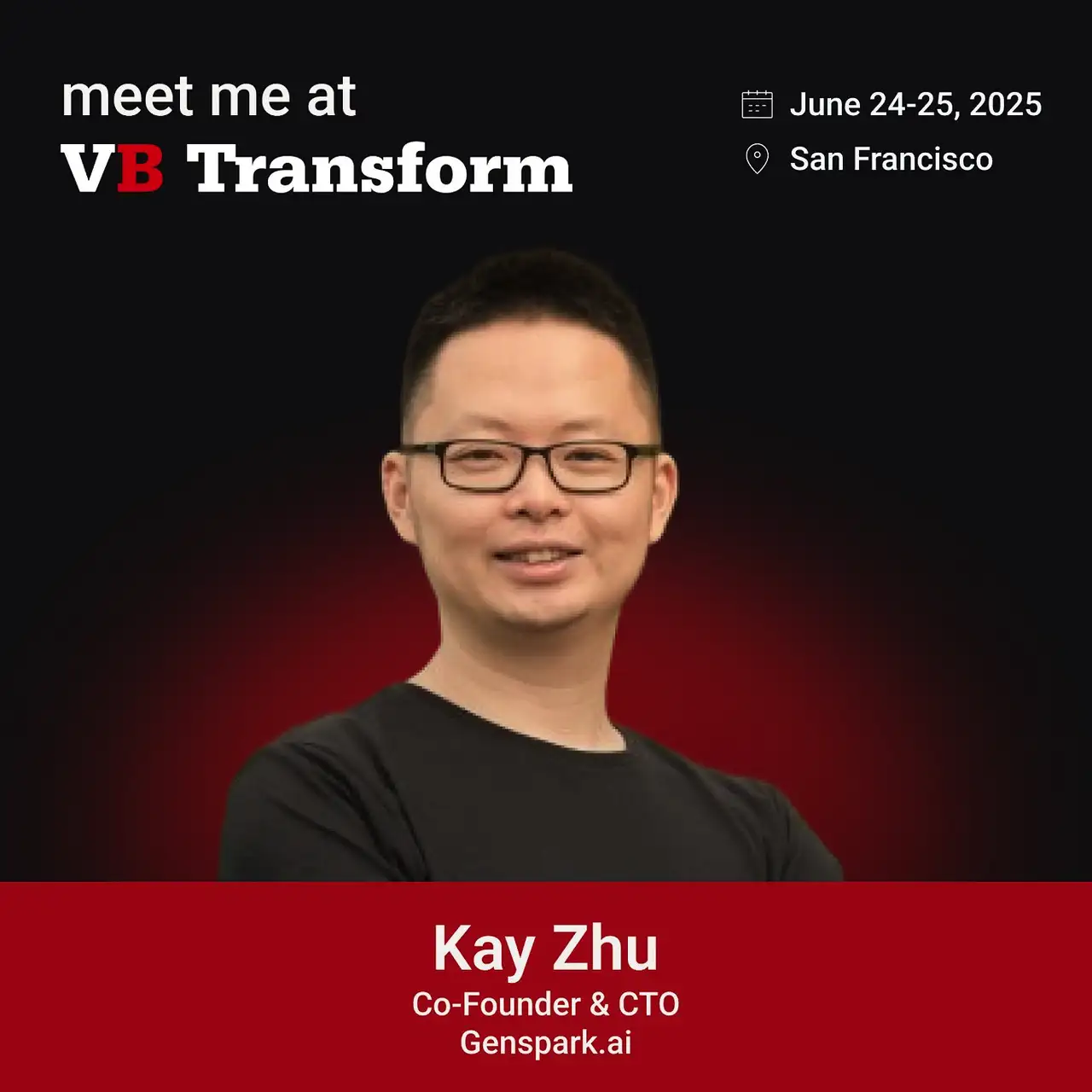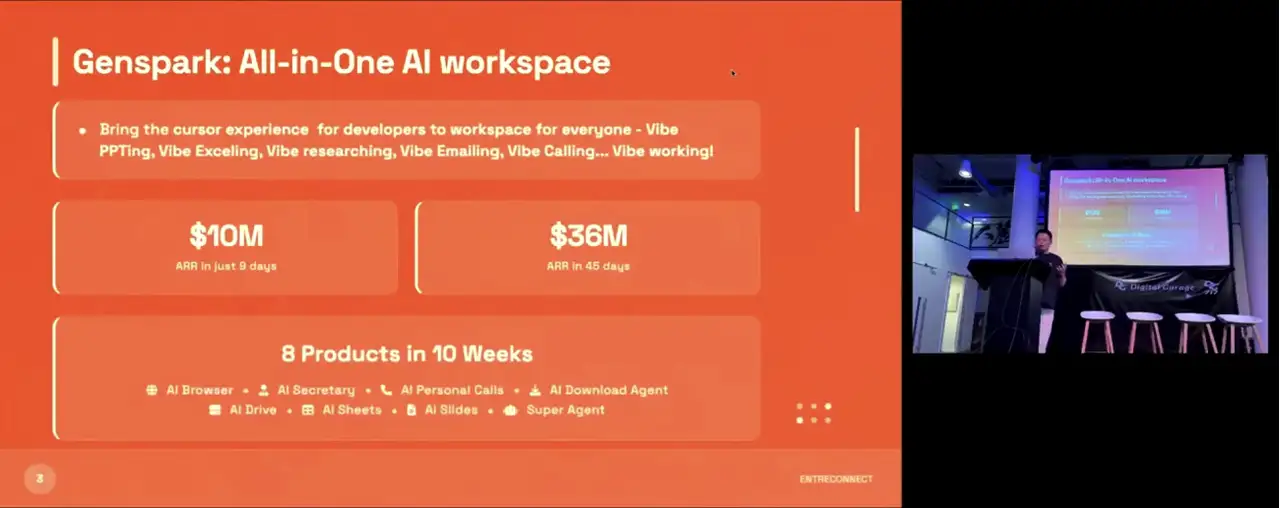$36M in 45 Days: GenSpark’s “Super Agent” revolution

Vivi Carter · 23, July 2025

San Francisco, VB Transform 2025 — Kay Zhu, CTO and co-founder of GenSpark, recently delivered a groundbreaking talk titled “Less Control, More Tools”. In a concise 30-minute presentation, Kay walked the audience through how GenSpark—a highly specialized AI-native team—achieved $36 million Annual Recurring Revenue (ARR) in just 45 days. Their ingredients for success? A core team of 20, zero dollars on ads, four product launches in 10 weeks, and a user base of over 5 million.
What’s more striking is how their strategy systematically prioritized tools and autonomy (“super agents”), rather than micromanagement and rigid workflows. According to Kay Zhu:
“Don’t waste time managing people—focus on equipping them with the tools they need, and the team will run itself.”
This philosophy, delivered live on stage alongside real-time data demonstrations, challenges conventional leadership norms while underscoring the transformative power of AI agents integrated across every business function.
Below, we’ll unpack the core lessons from Zhu’s talk: how the “Less Control, More Tools” method can drive scale for both startup teams and businesses interested in AI adoption.
Super Agents: From Task Execution to Autonomy
Not Just Question-and-Answer Bots—Actual Digital Workers
The defining feature of GenSpark’s AI products isn’t raw computational power or algorithmic sophistication—it’s their ability to completely own tasks from start to finish. During his live demonstration, Kay Zhu showcased GenSpark’s super agent capabilities in real-time.
Take this example: Kay inputs a single sentence of instruction:
“Research Entra Connect and create a complete presentation for me.”
From that vague prompt, GenSpark’s AI agent autonomously:
- Researched Entra Connect online.
- Generated a presentation outline.
- Drafted every slide’s content.
- Edited layout, suggested visual enhancements, and tailored tones for presentation delivery.
Unlike standard chatbots that wait for additional instructions step-by-step, GenSpark’s agent commits to the full execution flow. Zhu described this innovation as being less like an assistant answering questions and more like a digital intern independently producing deliverables.
Another jaw-dropping moment came when Zhu demonstrated the system making phone calls:
- The AI dialed on his behalf to negotiate his presentation time slot during VB Transform.
- With logical persuasion and clarity, it successfully secured an earlier speaking slot—autonomously.
Real-world users also employ this feature in surprising ways: one Japanese user reportedly used GenSpark’s agent to quit their job via phone because they didn’t want to handle the awkward conversation themselves. These examples underscore the paradigm shift GenSpark aims to achieve: AI agents that stop being “helpers” and evolve into “partners.”
Core Super Agent Capabilities
GenSpark’s super agents rely on three interconnected pillars:
Intent Recognition from Ambiguity
- Users don’t need perfect instructions; agents interpret vague prompts and deduce what’s required.
Tool Autonomy
- Agents deploy GenSpark’s rich library of over 80 tools (e.g., Python scripting, document editing, database querying, video manipulation). These tools work modularly, enabling task flexibility instead of rigid work sequences.
Self-Correcting Mechanisms
- If a task isn’t executed perfectly or data is missing, the agent revisits prior steps, filling gaps on its own initiative. Think of it as “reviewing and redoing” its own work without human intervention.
Kay Zhu summarized this succinctly:
"Agents that don’t just follow commands—they own the process, adapt when errors arise, and deliver results autonomously. They’re not chatbots; they’re AI colleagues."
Task-Driven Development: Why Agents Must Push Boundaries
Let Agents Solve Problems, Not Follow Pre-Set Rules
GenSpark’s guiding principle—“Less Control, More Tools”—rejects traditional workflow rigidity. Zhu argues pre-designed workflows fail under dynamic, real-world conditions where tasks rarely conform to predictable patterns.
To illustrate this philosophy, he outlined GenSpark’s internal “execution loop”:
- Plan → Execute → Observe → Revise
Agents continuously learn from setbacks, adapt tools on the fly, and revisit incomplete results. This isn't just about automation—it’s cultivating resilience and adaptability, core traits of effective human problem-solving.
Tools as Foundations for Autonomy
Super agent power stems from its modular access to tools. GenSpark equips agents with capabilities ranging from simple presentation generation to API automation and beyond. Zhu notes:
“Two people can have similar skills, but one with better tools will always excel faster. The same principle applies to AI agents.”
By connecting tools into an integrated “action library,” agents work step-by-step but aren’t confined to rigid workflows. Instead, they dynamically combine relevant tools, behaving more like human collaborators piecing together solutions with ingenuity.
GenSpark’s success adds another twist: while typical AI frameworks like LangChain focus heavily on flowchart-like steps, Zhu emphasizes flexibility.
“We’re not building agents to follow lengthy workflows. We’re building them to improvise and complete tasks in unpredictable situations.”

How GenSpark’s Small Team Operates Like Many
Breaking Hierarchies: Everyone Collaborates
What’s equally fascinating isn’t just the tools GenSpark develops—it’s the human infrastructure behind them. With just 20 team members, each contributor works hands-on with AI systems. Zhu explained:
“There are no traditional product managers here. Our CEO is the only PM—and even our designers write code.”
This organizational flattening eliminates dependency on handoffs between specialists. Instead of siloed roles, every contributor directly engages with both tools and AI capabilities.
Hiring Mindset: Architect-Thinkers
GenSpark doesn’t recruit based on credentials or years of experience. Zhu shared the team's hiring framework: prioritize candidates who exhibit “architect-minded thinking”—those capable of designing functional workflows from scratch, from input to output.
Ideal hires exhibit:
- Initiative: Proactively start tasks and test tools without waiting for hand-holding.
- Delivery Ownership: Accountability for results (not just submitting ideas).
- Trial-and-Error Confidence: Willingness to experiment, adapt, and retry when mistakes occur.
As the AI systems evolve, GenSpark’s team evolves alongside them—knowing every core component, building capacity for integration, and scaling outputs as one cohesive unit.
Workflows Meet AI: A Hybrid Framework
Why AI Complements Standard Processes
Scaling companies often overlook one fundamental idea: traditional workflows handle “certainty” better, while AI excels in “uncertainty.” Kay Zhu doesn’t advocate replacing standard workflows altogether. Instead, GenSpark’s formula integrates human processes with distributed AI systems.
Consider GenSpark's hybrid architecture:
- Standard Processes: Optimized for predictable, repeatable tasks (e.g., payroll management, inventory tracking).
- AI Agents: Tackling the unpredictable edge cases (e.g., unexpected client requests, anomaly detection).
They call this framework:
Predictable Work Meets Adaptive Agents
For example: structured workflows process invoices, but when unique exceptions arise (e.g., multi-currency issues), GenSpark’s agents intervene dynamically—negotiating solutions faster than pre-designed systems.
Growth Through Network Effects
Functional Virality Drives Adoption
While marketing budgets are essential for most SaaS products, GenSpark achieved exponential user adoption entirely through product-led virality. Zhu attributed this success to interconnected tool experiences:
“One meaningful feature isn’t enough—those features need to link, creating a seamless chain of actions that pulls users deeper into the ecosystem.”
For example: agents create presentations → draft emails → schedule campaigns → analyze post-performance—all flowing intuitively within one product experience. This continuity makes users stick longer.
Another critical growth lever? Users actively demonstrating GenSpark’s utility to others, sparking word-of-mouth promotion. Zhu highlighted:
“Our strongest growth comes when users show colleagues how they solved tasks with GenSpark. That’s not marketing—it’s firsthand endorsement.”
Execution Velocity: Embracing Imperfection
Iterate Faster With Real User Feedback
Instead of spending months tinkering with “perfect” features, GenSpark prioritizes rapid product launches, collecting live user feedback to refine functionality. Zhu shared two operation principles:
Launch Fast, Learn Faster
- Early versions prioritize usability over perfection. Users help identify flaws, providing actionable insights for improvement.
Observe Directly
- GenSpark’s team actively monitors real users, pinpointing friction points (e.g., poor UI clarity) and solving them quickly.
Zhu summarized this approach:
“Our strategy isn’t about perfect builds—it’s about getting tools out, watching users react, and updating rapidly until things click.”
Concluding Thoughts
GenSpark’s rapid success reveals more than AI’s power—it illustrates how lean startups can thrive through adaptable workflows, embedded digital colleagues, and hyper-connected product ecosystems.
Their $36M ARR milestone wasn’t just a tech win. It reflects deeper cultural and organizational shifts:
- Less micromanagement, more empowerment via tools.
- Flexible workflows, powered by autonomous agents.
- Product growth, emerging organically from strong user experiences.
For mid-sized businesses or startups exploring AI adoption, GenSpark lays out an inspiring roadmap: adopt agents not purely for efficiency—but as co-creators that elevate your organization’s capabilities.
In this emerging age of AI-native teams, one truth becomes clear: those who learn this new way of working first will endure. GenSpark is already leading the way.
